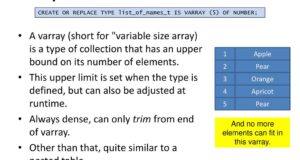REQUEST COMPLIMENTARY SQLS*PLUS LICENCE
Oracle Varrays

In Oracle PL/SQL Varray (an array with variable size) is an array whose number of elements can vary from zero (empty) to the declared maximum size.
To access a Varray element, use the variable_name(index) syntax:
- The lower boundary of the index is 1; the upper boundary is the current number of elements.
- The upper limit changes when the elements are added or removed, but it cannot exceed the maximum size.
When you store and extract a varray from the database, its indexes and the order of the elements remain stable.
Syntax to define and then declare a Varrays type variable in Oracle PL/SQL
TYPE type_varray IS {VARRAY | VARYING ARRAY} (size_limit) OF element_type [NOT NULL];
v_arr type_varray;
Parameters and arguments of the array
- type_varray – name of type Varray
- element_type – any PL/SQL data type, except for REF CURSOR
- size_limit is a positive integer literal representing the maximum number of elements in the array.
- v_arr – the name of a variable of the Varray type
Note:
- When defining a Varray type, you must specify its maximum size.
An example of how to use Varray in Oracle PL/SQL
DECLARE
TYPE Foursome IS VARRAY(4) OF VARCHAR2(15); -- Varray type
-- is a varray variable initialized by the constructor:
team Foursome := Foursome('John', 'Mary', 'Alberto', 'Juanita');
PROCEDURE print_team (heading VARCHAR2) IS
BEGIN
DBMS_OUTPUT.PUT_LINE(heading);
FOR i IN 1..4 LOOP
DBMS_OUTPUT.PUT_LINE(i) || '.' || team(i));
END LOOP;
DBMS_OUTPUT.PUT_LINE('---');
END;
BEGIN
print_team('2001 Team:');
team(3) := 'Pierre'; -- Change the values of the two elements
team(4) := 'Yvonne';
print_team('2005 Team:');
-- Call the constructor to assign new values to the Varray variable:
team := Foursome('Arun', 'Amitha', 'Allan', 'Mae');
print_team('2009 Team:');
END;
As a result, we get:
2001 Team:
1.John
2.Mary
3.Alberto
4.Juanita
---
2005 Team:
1.John
2.Mary
3.Pierre
4.Yvonne
---
2009 Team:
1.Arun
2.Amitha
3.Allan
4.Mae
---
In this example we defined Foursome as a local Varray type, declared a team variable of this type (initialized by the constructor) and defined the print_team procedure which printed Varray. The example calls the procedure three times:
- after initializing the variable,
- after changing values of two elements separately,
- and after using the constructor to change the value of all elements.
Using Varray
Varray should be used when:
- You know the maximum number of elements.
- You access the elements in sequence.
- Since you must store or retrieve all elements simultaneously, Varray may not be practical for a large number of elements.
PL/SQL tutorial: VARRAYs in Oracle Database
MORE NEWS
PreambleNoSql is not a replacement for SQL databases but is a valid alternative for many situations where standard SQL is not the best approach for...
PreambleMongoDB Conditional operators specify a condition to which the value of the document field shall correspond.Comparison Query Operators $eq...
5 Database management trends impacting database administrationIn the realm of database management systems, moreover half (52%) of your competitors feel...
The data type is defined as the type of data that any column or variable can store in MS SQL Server. What is the data type? When you create any table or...
PreambleMS SQL Server is a client-server architecture. MS SQL Server process starts with the client application sending a query.SQL Server accepts,...
First the basics: what is the master/slave?One database server (“master”) responds and can do anything. A lot of other database servers store copies of all...
PreambleAtom Hopper (based on Apache Abdera) for those who may not know is an open-source project sponsored by Rackspace. Today we will figure out how to...
PreambleMongoDB recently introduced its new aggregation structure. This structure provides a simpler solution for calculating aggregated values rather...
FlexibilityOne of the most advertised features of MongoDB is its flexibility. Flexibility, however, is a double-edged sword. More flexibility means more...
PreambleSQLShell is a cross-platform command-line tool for SQL, similar to psql for PostgreSQL or MySQL command-line tool for MySQL.Why use it?If you...
PreambleWriting an application on top of the framework on top of the driver on top of the database is a bit like a game on the phone: you say “insert...
PreambleOracle Coherence is a distributed cache that is functionally comparable with Memcached. In addition to the basic function of the API cache, it...
PreambleIBM pureXML, a proprietary XML database built on a relational mechanism (designed for puns) that offers both relational ( SQL / XML ) and...
What is PostgreSQL array? In PostgreSQL we can define a column as an array of valid data types. The data type can be built-in, custom or enumerated....
PreambleIf you are a Linux sysadmin or developer, there comes a time when you need to manage an Oracle database that can work in your environment.In this...
PreambleStarting with Microsoft SQL Server 2008, by default, the group of local administrators is no longer added to SQL Server administrators during the...















